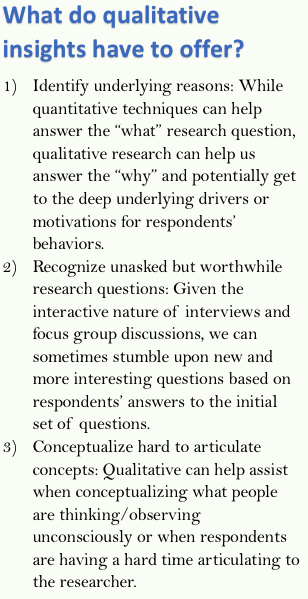Editor’s note: Monika Mahto is research manager and Hemnabh Varia is research analyst at management consulting firm Deloitte Services, India. Susan K. Hogan is research manager at Deloitte Services LP, Atlanta.
 Qualitative insight is often given only so much attention during the research development, collection and analysis process due to its sometimes perceived lack of objectivity or statistical validity. However, qualitative often has a sweet spot when it comes to providing a richness to existing research by adding color and life to other quantitative or categorical measures, as it can help a researcher in three ways: identifying underlying reasons, recognizing unasked (but worthwhile) research questions and conceptualizing hard to articulate concepts (see sidebar).
Qualitative insight is often given only so much attention during the research development, collection and analysis process due to its sometimes perceived lack of objectivity or statistical validity. However, qualitative often has a sweet spot when it comes to providing a richness to existing research by adding color and life to other quantitative or categorical measures, as it can help a researcher in three ways: identifying underlying reasons, recognizing unasked (but worthwhile) research questions and conceptualizing hard to articulate concepts (see sidebar).
There are several ways to get to each of the three objectives. In this article we will discuss two techniques developed in the 1990s that could be helpful in meeting these objectives through qualitative efforts.
The laddering interview technique, as the name suggests, can help researchers get to highly-detailed responses by asking interviewees focused follow-up questions based on their initial responses to potentially get at the reasons and underlying values driving behavior. By including the laddering technique as part of our research process for our study, “On the couch: Understanding consumer shopping behavior,” we uncovered the top-of-mind reasons – or instrumental values – why individuals chose to purchase products from where they did, which were all tied to convenience (e.g., location, curated products, minimal wait times and approachable yet unobtrusive sales associates). Moreover, by using this technique, we identified the individuals’ deeper, underlying reasons – terminal values behind these reasons that fell into three categories: control, conquest and a sense of worth via camaraderie.
Laddering helps researchers address the first issue of identifying underlying reasons and providing a way for getting at the causes driving human behavior – helping answer the deep “why.” In a second set of situations, we as researchers are sometimes not sure whether we are asking the right questions. With the use of follow-up and more detailed questions, laddering can help researchers uncover new questions that may be more germane to the research problem at hand.

Unconscious behaviors and cognitive choices
Sometimes respondents are not aware of the true reasons behind their underlying behaviors and derivative response. We don’t always know why we feel a certain way. Even if we know, we can’t fully describe the reasons. So, how do we as researchers provide the right cues for respondents to realize and express their unconscious behaviors and cognitive choices? That is where the Zaltman Metaphor Elicitation Technique (ZMET) method is often considered.
ZMET was developed by Gerald Zaltman, a professor at the Harvard Business School, in the 1990s. This research technique utilizes visual imagery and non-literal expressions such as metaphors to elicit responses. ZMET is based on the premise that certain constructs and mental models are used by people to guide their thinking about a particular research topic. However, these constructs lie in both our conscious, sub- and unconscious thoughts, and most of these influences that guide our reactions occur outside our level of awareness. With the aid of images and metaphors, ZMET can help the respondent connect the dots and conceptualize hard-to-articulate concepts.
Zaltman first used the technique in the 1990s while on vacation in Nepal. He provided low-cost, disposable cameras to local residents and asked them to take pictures that best describe life in their villages. When the pictures were collated, Zaltman discovered one common theme – most, if not all, photographers chose to omit people’s bare feet from their pictures. Upon further probing, the respondents said they didn’t want to show bare feet as this is a sign of poverty in Nepal. Zaltman would not have known about this theme – or that this was even an issue – had he asked a set of standard questions to the respondents or stuck to the research hypothesis and initial questions of interest.
Zaltman continued his exploration of this technique to answer tricky research questions by using images. In addition to social applications, the technique was also later used for business situations. A Danish hearing-aid manufacturer was trying to understand the underlying reasons for its plunging topline. During focus group discussions, people associated cost as a reason to postpone the purchase of a hearing aid. However, the company wanted to know if there were deeper factors at play. When the same set of respondents were provided some metaphors and asked to choose the ones they associate the product with, the two most commonly chosen metaphors were “old age” and “physically disabled,” suggesting that people associated hearing aids as symbols of being old and flawed, and hence avoided buying or using them.1 As the result of this research, the company revamped its product design with a new and fashionable styling in an attempt to counter this stereotype and improve sales. With the use of images and metaphors, the technique can be a strong tool for uncovering respondents’ unconscious thoughts.
The latest technologies
 There can be challenges, though, with the use of image-based qualitative analysis. A sample set should be large enough to provide a good interpretation of the population’s behavior. Fortunately, there typically isn’t a need to give away cameras to respondents. Today most of us are armed with a smartphone connected to a high-speed network that makes it fairly easy and low-cost to click and share photos. With a huge collection of images, the real challenge often lies in making sense of them all. With advancements in cognitive technologies such as image analytics and computer vision, a researcher can get the help he or she needs to scale up analysis relatively quickly. In the same way, a huge list of metaphors can be analyzed and effectively visualized using word clouds.
There can be challenges, though, with the use of image-based qualitative analysis. A sample set should be large enough to provide a good interpretation of the population’s behavior. Fortunately, there typically isn’t a need to give away cameras to respondents. Today most of us are armed with a smartphone connected to a high-speed network that makes it fairly easy and low-cost to click and share photos. With a huge collection of images, the real challenge often lies in making sense of them all. With advancements in cognitive technologies such as image analytics and computer vision, a researcher can get the help he or she needs to scale up analysis relatively quickly. In the same way, a huge list of metaphors can be analyzed and effectively visualized using word clouds.
Bringing it all together
The next time you are working on a primary research exercise, revisit some of these techniques to help uncover potentially interesting insights.
- Laddering and ZMET are two research techniques that can be used either standalone or in conjunction.
- With the onslaught of big data and newer quantitative techniques, it can be easy to disregard some methods but these methods can uncover deep insights.
- Without replacing/foregoing potentially newer techniques and advances in research, think of these as one or two more tools that may be valuable additions to the researchers’ array of methods.
- Revisiting these methods might help researchers complement their existing methods and avoid reinventing the wheel.
- Methods that once may have been impractical could now be more feasible given the ubiquity of digital photography.
Perhaps the combination of existing research techniques and new technology can bring out the best analysis.
This publication contains general information only and Deloitte is not, by means of this publication, rendering accounting, business, financial, investment, legal, tax, or other professional advice or services. This publication is not a substitute for such professional advice or services, nor should it be used as a basis for any decision or action that may affect your business. Before making any decision or taking any action that may affect your business, you should consult a qualified professional advisor.
Deloitte shall not be responsible for any loss sustained by any person who relies on this publication.
About Deloitte
Deloitte refers to one or more of Deloitte Touche Tohmatsu Limited, a U.K. private company limited by guarantee (“DTTL”), its network of member firms, and their related entities. DTTL and each of its member firms are legally separate and independent entities. DTTL (also referred to as “Deloitte Global”) does not provide services to clients. In the United States, Deloitte refers to one or more of the US member firms of DTTL, their related entities that operate using the “Deloitte” name in the United States and their respective affiliates. Certain services may not be available to attest clients under the rules and regulations of public accounting. Please see www.deloitte.com/about to learn more about our global network of member firms.
Copyright © 2017 Deloitte Development LLC. All rights reserved.
Endnotes
Shapiro, Stephen M. “Best Practices Are Stupid: 40 Ways to Out-Innovate the Competition,” Penguin, 2011.
